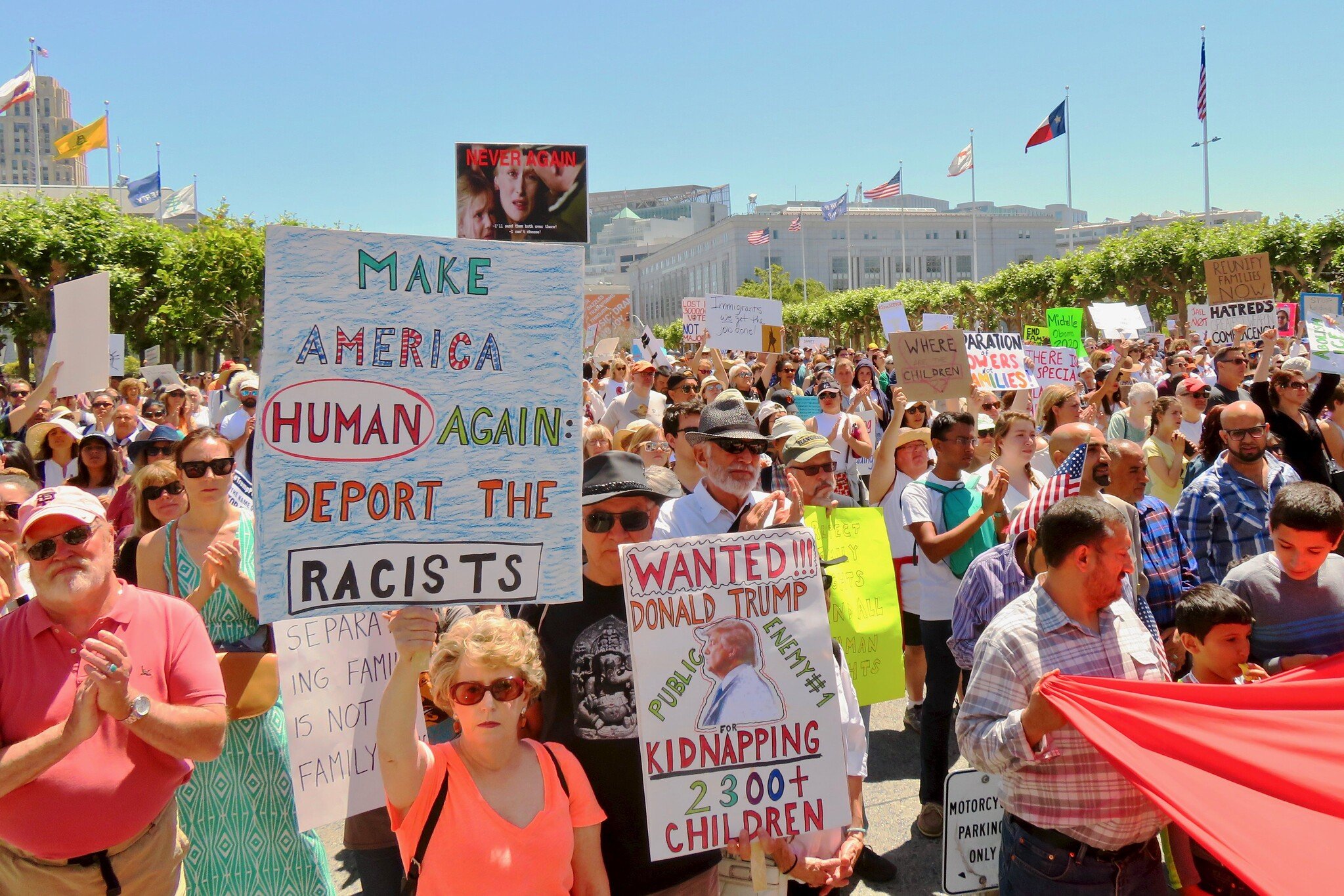The Sanctuary Movement
A Haven in the Churches
In the early 1980s, hundreds of thousands of Central Americans fled to the United States to escape violent Civil Wars. However it quickly became clear that the US Government was firmly opposed to granting these displaced people asylum, because of its own involvement in supporting and training the paramilitaries responsible for many of the worst atrocities. Instead the Reagan Administration claimed that the Central Americans arriving at the border were just economic migrants.
Many U.S. citizens felt this refusal to offer Salvadorans and Guatemalans sanctuary was unjust and immoral, as well as being counter to the intentions of the US’s new 1980 Refugee Act. In response, religious leaders began to organize the use of church buildings as public sanctuaries, where Central American asylum seekers could access food, shelter and legal advice.
March 24, 1982 press conference at University Lutheran Chapel. Credit: http://www.share-elsalvador.org
On 24 March 1982, five Bay Area churches and one church in Tucson, Arizona held coordinated press conferences in which they announced their intention to offer safe haven to undocumented Central American refugees who requested protection from deportation. In Berkeley, representatives of the churches involved were joined by three Salvadoran asylum seekers who agreed to risk speaking publicly in order to draw attention to the plight of the El Salvadorans and Guatemalans being refused status by the Government. The Sanctuary movement quickly spread across the US: by 1985 over 500 churches and synagogues were active members of the Sanctuary network.
The Central American Sanctuary movement drew on a long tradition of offering refuge in churches, including early Jewish and Christian social teachings and Medieval law. There were also clear connections to the anti-slavery Underground Railroads that had operated across the U.S. in the nineteenth century, and more recent sanctuaries offered too . At first the Sanctuary movement was focused on helping Central American refugees to continue moving north to Canada where – it was hoped – those with credible claims would find it easier to get settled status. But after the U.S. government put pressure on the Canadian government to refuse Central American claims, the Movement shifted to housing asylum seekers in the U.S., and raising public awareness of their plight, often by encouraging those seeking sanctuary to speak publicly about their experiences to church congregations.
Sanctuary Cities
Determined to crack down on the Sanctuary Movement, in January 1985 the US government launched a ten-month investigation, Operation Sojourner, that sent paid informants into sanctuary communities to gain the trust of members and report back to federal officials. In what became known as "The Sanctuary Trials", dozens of defendants charged with alien smuggling claimed to be upholding the US Constitution and International Law through their acts of civil disobedience. Although they lost their cases, the defendants won enormous public sympathy for their cause and helped to shift public opinion, laying the ground for a more sympathetic policy framework. In 1990, Congress would pass legislation allowing Salvadoran and Guatemalans in the US to apply for “Temporary Protected States”, providing protection against deportation.
As public sympathy for Central American refugees grew, the Sanctuary movement started to focus on limiting immigration raids and civic cooperation with the federal Immigration and Naturalization Service, INS (a predecessor to today’s ICE). Los Angeles was the first city to pass a sanctuary policy in 1979, instructing police officers not to concern themselves with individuals’ immigration status. In February 1985 the Berkeley City Council voted 8-1 to declare all of Berkeley a Sanctuary for undocumented refugees. In December San Francisco followed suit, declaring itself a “City of Refuge” for Salvadoran and Guatemalan refugees.
In a landmark resolution that became the basis for many other Sanctuary City declarations, San Francisco’s supervisors affirmed that the city would not discriminate against these refugees on the basis of their immigration status, and would not carry out federal immigration policy (though its officials would also not directly impede the work of INS). 50,000 San Francisco residents signed petitions advocating for the resolution. San Francisco Sheriff Michael Hennessey was among a number of law enforcement officials who spoke out in favor of the resolution.
“In January 1982, we were approached to sponsor Omar and Ingrid Mayorga and their infant son, who had fled the military assault on their campus in San Salvador and entered the U.S. illegally. Soon after, pastors from five congregations met and asked, ‘Why don’t our congregations declare sanctuary?”
Poster in the Mission, which you can see while walking Coffee Country
Sanctuary Today: A Continuing Struggle
However the 1985 resolution was still largely symbolic. It was only in 1989 that San Francisco passed a binding Sanctuary City Ordinance, which is still in force today. Protecting not just Salvadoran and Guatemalan but all undocumented immigrants, the ordinance prohibits City employees from using City funds or resources to assist Immigration and Customs Enforcement (ICE) in the enforcement of Federal immigration law. In 2013, San Francisco strengthened these provisions, passing the “Due Process for All” Ordinance. This ordinance limits when City law enforcement officers may give ICE advance notice of a person’s release from local jail. It also prohibits cooperation with ICE detainer requests, sometimes referred to as “ICE holds.”
The Sanctuary City movement faced fierce backlash. Almost immediately, the US government threatened to cut off federal funding to San Francisco if the city did not soften the Sanctuary City ordinance. This threat to withdraw funding unless cities cooperate with federal immigration enforcement has been repeated in ensuing decades, most recently by the Trump Administration. Today, Republican-led states – including Arizona, Texas and Florida – have all passed legislation banning Sanctuary Cities. Many commentators, including former President Donald Trump, have argued that Sanctuary Cities are unsafe, increasing crime and leaving ordinary Americans at risk of attack from violent criminals, although multiple research studies have shown no association between Sanctuary City declarations and levels of crime.
Yet despite this opposition. In 2017, California was declared the first Sanctuary State in the nation. Today, over 200 cities and 10 states are officially part of the Sanctuary Cities movement. The roots of many other Immigrant Rights campaigns – like the DREAMers youth movement and the Deferred Action for Childhood Arrivals (DACA) initiative – link to discussions that began in the 1980s in response to the Salvadoran refugee wave.
Protests on 30 June 2018 outside San Francisco City Hall. Credits: Fabrice Florin by CC 2.0 BY SA
Sanctuary City Project
Berkeley’s Sanctuary Movement, Found SF
Sanctuary Cities: The Politics of Refuge, Loren Collingwood and Benjamin Gonzalez-O’Brien
Want to Learn More?
In the Spirit of Sanctuary: Sanctuary-city Policy Advocacy in San Francisco, California, Peter Mancina
Sanctuary City Toolkit, National Immigration Law Center




